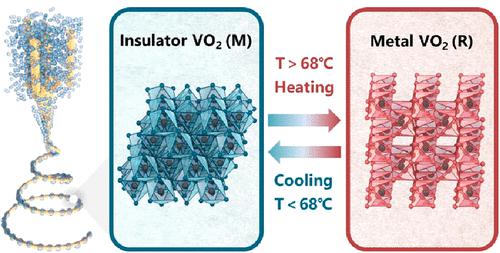当前位置:
X-MOL 学术
›
Nano Lett.
›
论文详情
Our official English website, www.x-mol.net, welcomes your
feedback! (Note: you will need to create a separate account there.)
Phase-Engineered VO2 Metal Nanofiber Enables a Metal–Insulator Transition for Bidirectional Thermal Reallocation
Nano Letters ( IF 9.6 ) Pub Date : 2023-06-30 , DOI: 10.1021/acs.nanolett.3c02094
Hongyu Guo 1 , Lirui Si 1 , Jianyong Yu 1, 2 , Xueli Wang 1, 2 , Yang Si 1, 2
Nano Letters ( IF 9.6 ) Pub Date : 2023-06-30 , DOI: 10.1021/acs.nanolett.3c02094
Hongyu Guo 1 , Lirui Si 1 , Jianyong Yu 1, 2 , Xueli Wang 1, 2 , Yang Si 1, 2
Affiliation

|
Phase change materials (PCMs) are appealing for their fascinating capability of thermal reallocation, assisting widely in many areas of human productivity and life. However, it has remained a significant challenge to attain shape stability, temperature resistance, and microscale continuity in PCMs while maintaining sufficient phase change performance. Here we report a sol epitaxial fabrication strategy to create metal–insulator transition nanofibers (MIT-NFs) composed of monoclinic vanadium dioxide. The MIT-NFs are further assembled into self-standing two-dimensional membranes and three-dimensional aerogels with structural robustness. The resulting series of metal–insulator transition materials exhibits the integrated features of solid–solid phase change properties, shape stability, and thermal reallocation properties. The integral ceramic characteristic also provides the MIT-NFs with surface stiffness (54 GPa), temperature resistance (−196° to 330 °C), and thermal insulator properties. The successful fabrication of these captivating MIT materials may provide new perspectives for next-generation, shape-stable, and self-standing PCMs.
中文翻译:

相工程 VO2 金属纳米纤维实现金属-绝缘体转变,实现双向热重新分配
相变材料 (PCM) 因其令人着迷的热重新分配能力而引人注目,在人类生产力和生活的许多领域发挥着广泛的作用。然而,在保持足够的相变性能的同时,实现相变材料的形状稳定性、耐温性和微尺度连续性仍然是一个重大挑战。在这里,我们报告了一种溶胶外延制造策略,用于创建由单斜晶二氧化钒组成的金属-绝缘体过渡纳米纤维(MIT-NF)。MIT-NF 进一步组装成具有结构坚固性的自支撑二维膜和三维气凝胶。由此产生的一系列金属-绝缘体过渡材料表现出固-固相变特性、形状稳定性和热重新分配特性的综合特征。整体陶瓷特性还为 MIT-NF 提供了表面刚度 (54 GPa)、耐温性(−196° 至 330 °C)和隔热特性。这些迷人的 MIT 材料的成功制造可能为下一代形状稳定且独立的 PCM 提供新的视角。
更新日期:2023-06-30
中文翻译:

相工程 VO2 金属纳米纤维实现金属-绝缘体转变,实现双向热重新分配
相变材料 (PCM) 因其令人着迷的热重新分配能力而引人注目,在人类生产力和生活的许多领域发挥着广泛的作用。然而,在保持足够的相变性能的同时,实现相变材料的形状稳定性、耐温性和微尺度连续性仍然是一个重大挑战。在这里,我们报告了一种溶胶外延制造策略,用于创建由单斜晶二氧化钒组成的金属-绝缘体过渡纳米纤维(MIT-NF)。MIT-NF 进一步组装成具有结构坚固性的自支撑二维膜和三维气凝胶。由此产生的一系列金属-绝缘体过渡材料表现出固-固相变特性、形状稳定性和热重新分配特性的综合特征。整体陶瓷特性还为 MIT-NF 提供了表面刚度 (54 GPa)、耐温性(−196° 至 330 °C)和隔热特性。这些迷人的 MIT 材料的成功制造可能为下一代形状稳定且独立的 PCM 提供新的视角。































 京公网安备 11010802027423号
京公网安备 11010802027423号